VANCOUVER, BRITISH COLUMBIA, April 13, 2021 -- SALAZAR RESOURCES LIMITED (TSXV: SRL, OTCQB: SRLZF) (“Salazar” or the "Company") is pleased to provide an update on the exploration activities within its wholly-owned portfolio of properties.
Mapping, and rock chip and soil sampling at Los Santos has been carried out over approximately 12% of the area (Figure 1). Initial results indicate the area has gold potential (Figure 2). Nearby, at Los Osos, drilling is underway with OSOS-03 at a depth of 508 m (Figure 3). The targeted hole depth is 500-600 m, depending on mineralization intensity, and the core will be logged prior to despatch for assay.
A geophysical survey at Macara Mina has highlighted feeder structures and possibly an intrusion at depth, both of which are associated with previously reported geological and geochemical anomalies (Figure 4). Drilling is planned at Macara Mina in H2 2021, contingent on the requisite permits being granted.
At Rumiñahui preparations for a preliminary drill program of 3,000 m to test gold-copper targets are well advanced. The core shed is complete, and the team is ready to start drilling as soon as the requisite water permits are received.
Perforaciones Andesdrill S.A, a wholly owned subsidiary of Salazar Resources, currently has one rig deployed at Los Osos, another two rigs currently available for work on the Curipamba and Pijili projects with Adventus Mining, and a fourth rig completing maintenance in HQ at Las Naves and ready to be deployed. The rigs will continue to work across the broader portfolio, as the drilling schedule demands, providing cost-effective drilling services for the Company.
Fredy E. Salazar, CEO and President of Salazar Resources commented, "Our drill rigs are turning, and we have projects advancing in both the carried and the wholly-owned portfolio of properties. In particular, it will be great to see our original discovery at El Domo reach the milestone of a completed Feasibility Study later this year.
2021 remains on track to be Salazar’s busiest ever year, as we explore and delineate in the search for the next great copper-gold discovery. Not only that, but in this election year we reiterate our commitment to ensuring that all of our exploration and development activities have a positive impact on Ecuadorian communities and the economy. Our successful track record of working closely with communities to bring exploration projects to development phase attests to this.”
Los Santos
Los Santos 2.1 lies in a district with a well-established tradition of gold panning and artisanal gold mining. The licence is adjacent to identified mineral resources at Lumina Gold’s 17-million-ounce Cangrejos project (10.4 million oz indicated and 6.6 million oz inferred - see Lumina Gold’s news release dated June 9, 2020), and near Salazar Resources’ Los Osos property. Salazar Resources field crews have mapped about 12% of the 2,215-hectare licence area so far, with a number of soil and rock chip samples collected and assayed (see Figure 1, below).
The geochemical plots in Figure 2 (below) show that the gold and the copper anomalies are coincident, with gold values high relative to copper. The presence of porphyritic intrusions and artisanal development on structures has been noted, but so far the intense brecciation seen at Los Osos has not been encountered. Fieldwork continues and the aim of having drill targets developed by mid-year remains on track.
Los Osos
Two holes within the Phase 1 drilling program at the Osos project, El Oro, Ecuador, have already been completed. The drilling is designed to define mineralized breccias and test for the presence of the upper portions of a mineralized porphyry. The northernmost hole of the two, OSOS-01, successfully intersected hydrothermal breccias, sulphides including chalcopyrite, clay alteration, quartz veining, veinlets, and stockworks, with elevated to anomalous gold mineralization. The core indicates that the hole was drilled into the upper part of a mineralized porphyry system, and OSOS-03 is a step-out to the north to test the continuity of the mineralization. OSOS-03 has an azimuth of 270o, and a dip of 60o (see Figure 3, below). OSOS-03 has reached a depth of 508 m, intersecting core visually similar to OSOS-01, with sulphides, breccias, and porphyritic intrusions. The targeted hole depth was 500-600 m, depending on mineralization intensity, and the core will be logged prior to despatch for assay.
After OSOS-03, Salazar is planning to drill test the high-grade structures in the northeast of the property. Drilling is being carried out by Perforaciones Andesdrill S.A, , the wholly-owned subsidiary of Salazar Resources.
The property is located in the Miocene Porphyry belt of Ecuador which is becoming an increasingly important zone of discoveries. It sits at the western end of the Cangrejos-Zaruma intrusive belt in southern Ecuador. This geologic belt is typified by multiple nested late Oligocene to Early Miocene intrusions, punctured and intruded by a number of porphyry dikes and breccia pipes. The approximately 20 Ma age of the intrusions in the Zaruma intrusive belt is the same as that of the giant Chilean porphyries which range in age from 10-40 Ma years.
Macara
In late 2020 a geophysical survey was completed at Macara Mina. The Prospect was surveyed, where possible, on 17 N-S lines 100 m apart with magnetic and gravity surveys by EIRL of Peru. An interpretation of the data was carried out by Brian Williams, Consultant Geophysicist at Williams Geophysics Ltd (UK).
A portion of the area in the southwest could not be surveyed due to prohibitively steep terrain. Due to the rugged topography figures 4 and 5, below, show slices extracted at depth below the surface rather than at horizontal intervals.
The main magnetic body lies beneath the valley in the northern part of the grid, near the center of the large gold-bearing geochemical anomaly as shown in Figure 4. This suggests that the gold is associated with the magnetic body, and the survey showed that the anomaly persists at depth. Figure 4 shows the Magnetic Vector Inversion (“MVI”) at a depth of 200 m below surface, and the anomaly is clear for the -50 m and -100 m levels as well. The magnetic sources appear to lie in an arc trending SSW from north to south across the grid. MVI was used as that was found to best accommodate the remnant magnetic fields in the magnetic sources.
The gravity survey did not pick up a large dense body that would have potentially indicated a massive sulphide occurrence but it did highlight an area of low density in the northern part of the license area. As can be seen in Figure 5, below, the gravity low coincides well with the hydrothermal breccias and gold anomalies shown in the rock samples. The anomaly improves in resolution with depth, and the figure below uses a depth of 500 m as it shows a potential correlation between the gravity signal and the geochemical signal more clearly than shallower slices.
The combined gravity and magnetic anomalies, coupled with the geology indicate that the features may well be part of a feeder system or the host of the mineralization seen at surface. Thick units of pillow lavas are evident in the area, and the low density zone under the geochemical anomaly could be generated by an intrusion.
Rumiñahui
At Rumiñahui, preparations for a preliminary drill program of 3,000 m to test gold-copper targets are complete, bar the water use permit. Drilling will be the culmination of years of positive and constructive dialogue with the local community. The drill program is being designed to test historic adits, old workings, near surface veins and stockworks that Salazar believes may be linked to an underlying porphyry. The core shed and logging areas are ready, as are all the support and logistics systems. The Company has complied with the regulatory requirements to qualify for drilling and is now awaiting final sign-off from the local authorities.
QAQC
Salazar maintains a rigorous chain-of-custody and quality assurance/quality control program that includes the insertion of certified standard control samples and blanks, and re-analysis of samples with high levels (over limit) of gold, copper and zinc. All samples were analysed by Inspectorate Services Perú S.A.C. (Bureau Veritas), a certified ISO 17025:1999 and ISO 9001:2000 laboratory. The laboratory also maintains a QAQC program that includes insertion of blanks, standards and duplicate reanalysis of selected samples. Gold was analysed by fire assay – atomic absorption spectroscopy (FA-AAS). Silver, copper, zinc and other elements were analyzed by aqua regia extraction with an Inductively Coupled Plasma — Mass Spectroscopy (ICP-MS) finish.
Qualified Person
Kieran Downes, Ph.D., P. Geo., a Qualified Person as defined by National Instrument 43-101, has reviewed and verified the technical information provided in this release.
About Salazar
Salazar Resources is focused on creating value and positive change through discovery, exploration and development in Ecuador. The team has an unrivalled understanding of the geology in-country and has played an integral role in the discovery of many of the major projects in Ecuador, including the two newest operating gold and copper mines.
Salazar Resources has a wholly owned pipeline of copper-gold exploration projects across Ecuador with a strategy to make another commercial discovery and farm-out non-core assets. The Company actively engages with Ecuadorian communities and together with the Salazar family it co-founded The Salazar Foundation, an independent non-profit organisation dedicated to sustainable progress through economic development.
The Company already has carried interests in three projects. At its maiden discovery, Curipamba, Salazar Resources has a 25% stake fully carried through to production. A feasibility study is underway and a 2019 PEA generated a base case NPV(8%) of US$288 million. At two copper-gold porphyry projects, Pijili and Santiago, the Company has a 20% stake fully carried through to a construction decision.
Figure 1. Soil geochemistry sample points, Los Santos, El Oro, Ecuador
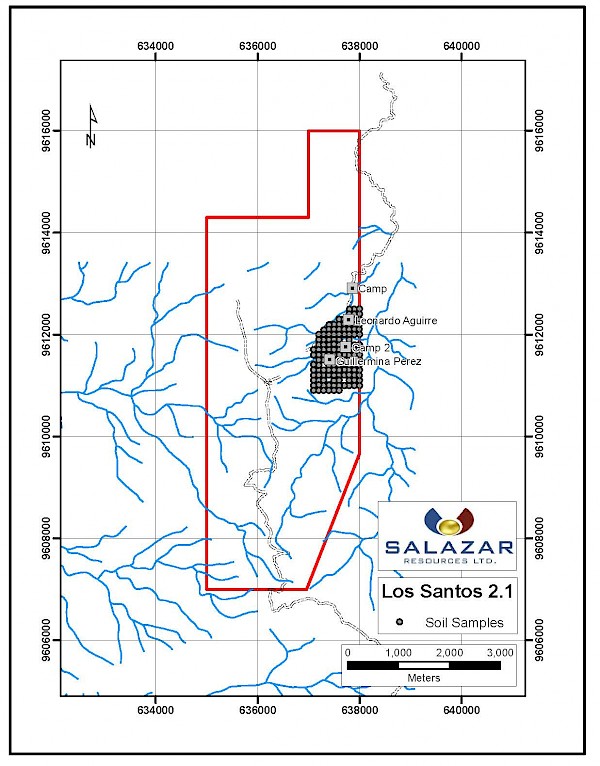
Source: Salazar Resources
Figure 2. Copper and Gold soil geochemistry, Los Santos, El Oro, Ecuador
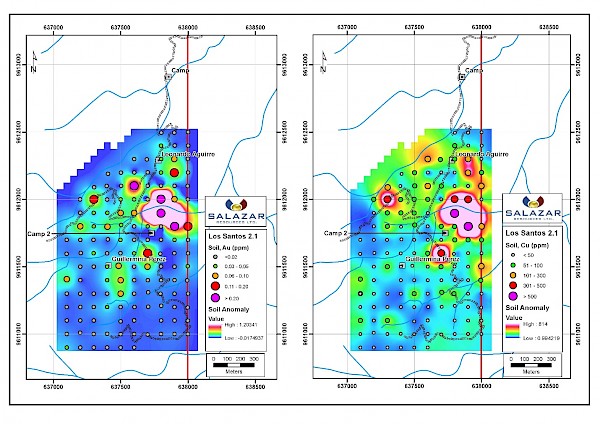
Source: Salazar Resources
Figure 3. Drill Plan, Los Osos, El Oro, Ecuador
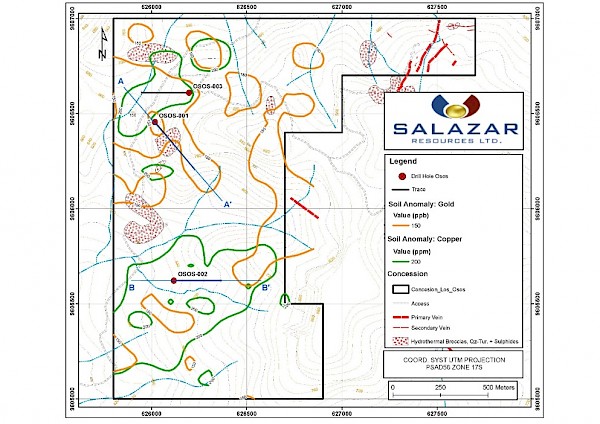
Source: Salazar Resources
Figure 4. Combined geochemistry and geophysics (magnetics) at Macara
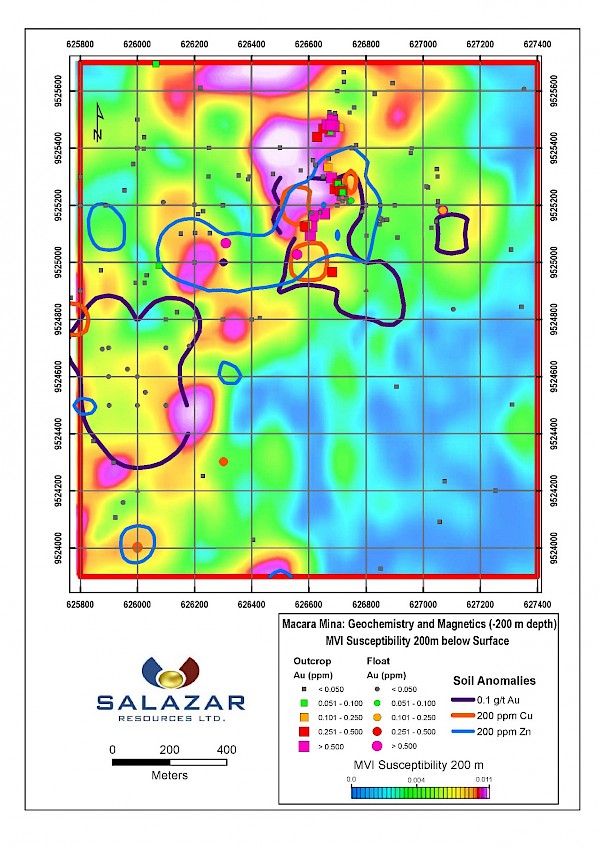
Source: Salazar Resources
Figure 5. Combined geology and geophysics (gravity) at Macara
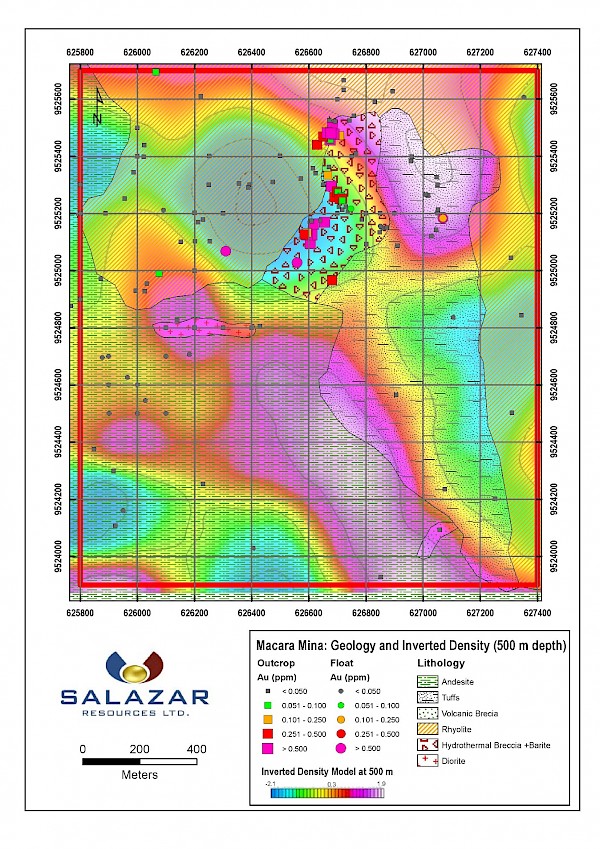
Source: Salazar Resources

